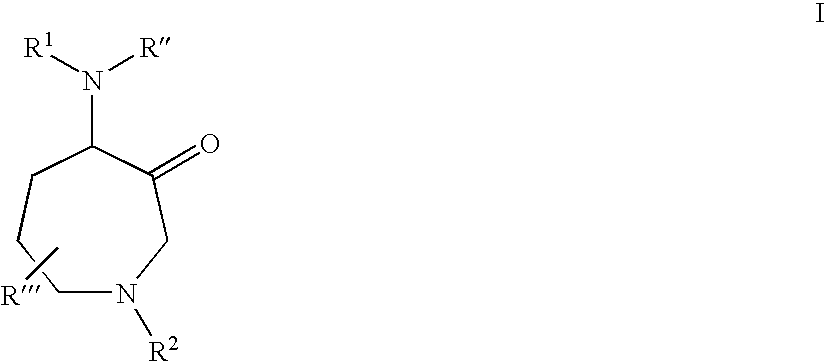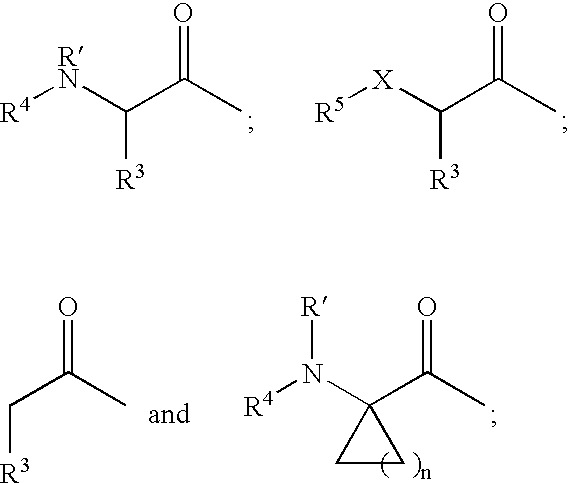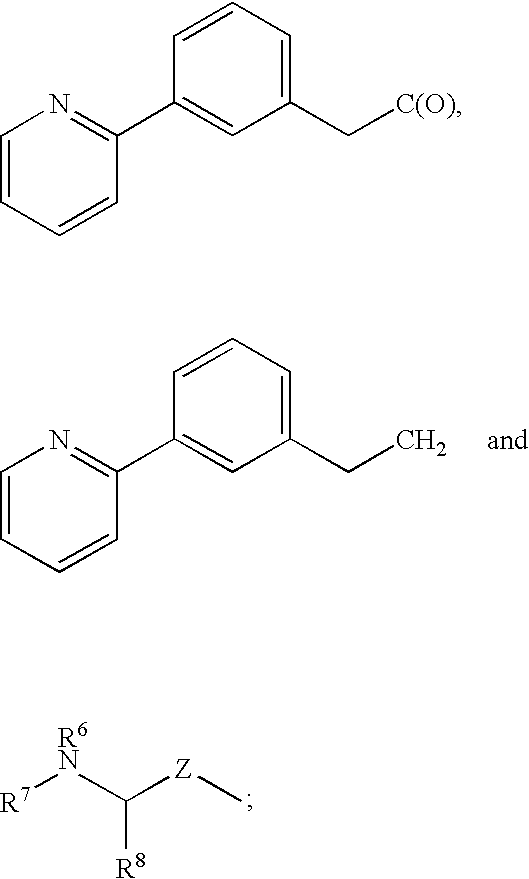Protease inhibitors
a protease inhibitor and c16alkyl4aminoazepan3one technology, applied in the direction of antibacterial agents, drug compositions, antiparasitic agents, etc., can solve the problems of minimal trauma, increased fracture risk, and known inhibitors that are not considered suitable for use as therapeutic agents in animals
- Summary
- Abstract
- Description
- Claims
- Application Information
AI Technical Summary
Problems solved by technology
Method used
Image
Examples
example 1
5-Methoxy-benzofuran-2-carboxylic acid {(S)-3-methyl-1-[(4S,6S)-6-methyl-3-oxo-1-(pyridine-2-sulfonyl)-azepan-4-ylcarbamoyl]-butyl}-amide
[0520]
5-Methoxy-benzofuran-2-carboxylic acid {(S)-3-methyl-1-[(4R,6R)-6-methyl-3-oxo-1-(pyridine-2-sulfonyl)-azepan-4-ylcarbamoyl]-butyl}-amide
[0521]
a. Allyl-(2-methyl-pent-4-enyl)-amine
[0522] To a solution of 2-methyl-pent-4-enoic acid ethyl ester (7.1 g, 50 mmol) was added dropwise a solution of DIBAL (1.0 M in hexanes, 75 ml) at −78 C over 1.0 h. After the addition, the reaction mixture was stirred at −78 C for another hour. The reaction was quenched with saturated NH4Cl (10 ml) and 4% HCl, then was extracted with EtOAc (3×100 ml). The combined organic extracts were dried with MgSO4, filtered, concentrated by rotary evaporation and the crude reaction product was used in the next reaction without further purification. 2-Methyl-4-pentenal (3.3 g, 33.7 mmol) was dissolved in CH2Cl2 (100 ml). To this solution allylamine (2.9 g, 50.5 mmol) was add...
example 2
Benzo[b]thiophene-2-carboxylic acid {(S)-1-[(4S,6S)-6-methyl-3-oxo-1-(pyridine-2-sulfonyl)-azepan-4-ylcarbamoyl]-3-methyl-butyl}-amide
[0531]
benzo[b]thiophene-2-carboxylic acid {(S)-1-[(4R,6R)-6-methyl-3-oxo-1-(pyridine-2-sulfonyl)-azepan-4-ylcarbamoyl]-3-methyl-butyl}-amide
[0532]
[0533] Following the procedure of Example 1 (a-i), except substituting “benzo[b]thiophene-2-carboxylic acid” for “5-methoxy-benzofuran-2-carboxylic acid” gave the title compound: MS (M+H+); 1H-NMR (400 Hz, CDCl3): d (ppm): 8.69(d, 1H), 7.97-7.78(m, 5H), 7.41-7.39(m, 3H), 6.95(d, 1H), 6.65(d, 1H), 5.25(m, 1H), 4.71-4.60(m, 2H), 3.86(d, 1H), 3.80(m, 1H), 2.98(d, 1H), 2.05(m, 2H), 1.75-1.55(m, 4H), 1.18(d, 3H), 0.97(d, 6H); The diastereomers were separated by HPLC. Diastereomer 1: MS (M+H+): 557.2; Diastereomer 2: MS (M+H+): 557.2
example 3
3-Methyl-benzofuran-2-carboxylic acid {(S)-1-[(4S,6S)-6-methyl-3-oxo-1-(pyridine-2-sulfonyl)-azepan-4-ylcarbamoyl]-3-methyl-butyl}-amide
[0534]
; and
3-methyl-benzofuran-2-carboxylic acid {(S)-1-[(4R,6R)-6-methyl-3-oxo-1-(pyridine-2-sulfonyl)-azepan-4-ylcarbamoyl]-3-methyl-butyl}-amide
[0535]
[0536] Following the procedure of Example 1 (a-i), except substituting “3-methyl-benzofuran-2-carboxylic acid” for “5-methoxy-benzofuran-2-carboxylic acid” gave the title compound: MS (M+H+) 555.2; 1H-NMR (400 Hz, CDCl3): d (ppm): 8.68(d, 1H), 7.93(m, 2H), 7.59-7.27(m, 5H), 7.03-6.96(dd, 2H), 5.26(m, 1H), 4.70-4.61(m, 1H), 3.82(d, 1H), 3.76(m, 1H), 2.99(d, 1H), 2.60(s, 3H), 2.05(m, 2H), 1.76-1.58(m, 5H), 1.19(d, 3H), 0.97(d, 6H); The diastereomers were separated by HPLC. Diastereomer 1: MS (M+H+): 555.2; Diastereomer 2: MS (M+H+): 555.4
PUM
| Property | Measurement | Unit |
|---|---|---|
| density | aaaaa | aaaaa |
| Electrospray mass | aaaaa | aaaaa |
| Electrospray mass spec | aaaaa | aaaaa |
Abstract
Description
Claims
Application Information
 Login to view more
Login to view more - R&D Engineer
- R&D Manager
- IP Professional
- Industry Leading Data Capabilities
- Powerful AI technology
- Patent DNA Extraction
Browse by: Latest US Patents, China's latest patents, Technical Efficacy Thesaurus, Application Domain, Technology Topic.
© 2024 PatSnap. All rights reserved.Legal|Privacy policy|Modern Slavery Act Transparency Statement|Sitemap



